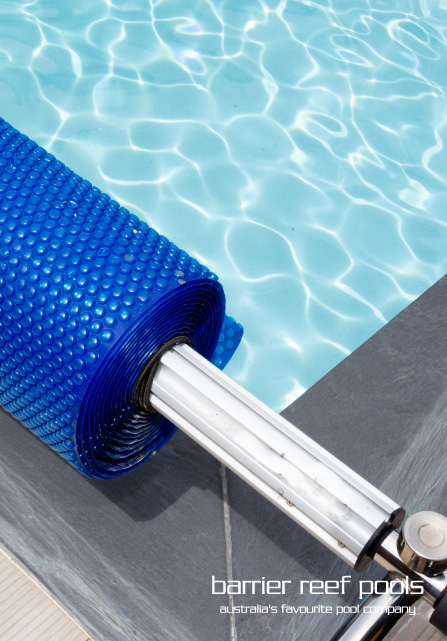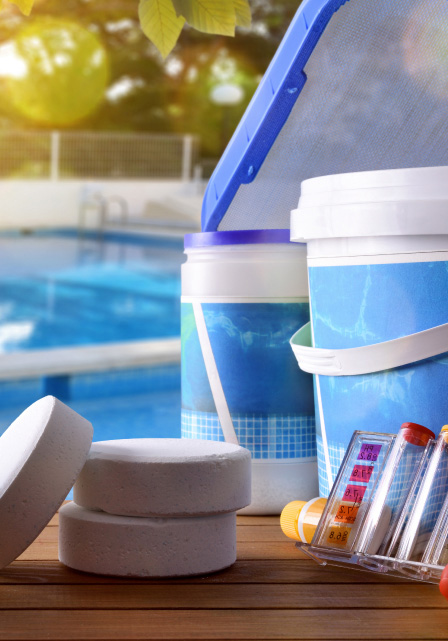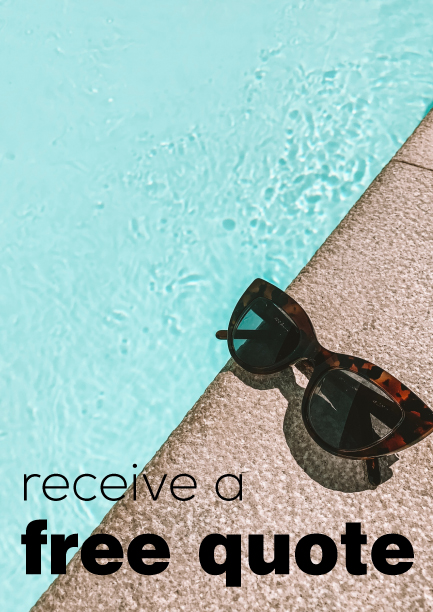The Complete Pool Maintenance Checklist
You don't have to navigate your way through pool maintenance alone. We've put together the ultimate pool maintenance checklist to simplify pool care and to free up your time for more important things - like swimming!

Water Testing Kit
Water testing kits are a godsend when it comes to looking after the water quality of your pool. You can grab one online or from your local hardware or pool store relatively inexpensively. They allow you to test the chemical levels of your pool water, providing you with an on-the-spot indication of what’s balanced and what’s not. Aim to do this weekly. This is what are you looking for:
1. Chlorine levels – Test twice weekly, more when the weather is warm.
2. pH levels – Twice weekly at the minimum.
3. Total alkalinity (TA) – Once a week and more if the pH levels have changed.
4. Calcium hardness levels – Once a month.
5. Stabiliser (cyanuric acid) – Once a month.
6. Total dissolved solids (TDS) – Once a month.
Pool Chemicals
Without pool chemicals, your pool would become stagnant and unsanitary to swim in rather quickly. Maintaining the correct doses of pool chemicals ensures your pool remains crystal-clear and healthy. Not only that, but it also helps to keep your pool equipment functioning to its best and prevents avoidable damage. Here are some common pool chemicals that you should add to your pool maintenance checklist if you haven’t already:
1. Chlorine
2. The sanitising agent that your pool uses (salt, minerals etc)
3. Stabiliser
4. pH balancer
5. Calcium balancer
6. Alkalinity balancer
There are others that you may need along the way however, these are the main ones you should have stocked and ready to go when need be. Restock when your chemicals are getting low.

Pool Maintenance Accessories
No pool maintenance checklist is complete with a few trusty pool cleaning accessories. Here are some essential items:
1. Telescopic pool pole
2. Brush attachment
3. Leaf scoop attachment
4. Vacuum attachment (if you are manually cleaning your pool)
Pool Cleaner
If you haven’t already got an automatic cleaner for your pool, there are many reasons why you should consider one. While they are an initial outlay, they can cut your physical cleaning time down dramatically. There are several different options, all with various features and price points. More advanced cleaners such as robotic cleaners clean the water meticulously and are practically self-sufficient. They are expensive to buy outright, but the long-term cost-saving benefits they offer are unmatched by other pool cleaners which makes them a worthwhile purchase if you want to save money.
Empty The Skimmer And Clean Out Your Filters
Your skimmer basket is where most of the floating debris and leaves will end up. They can fill up fast, especially if there has been a lot of wind or a storm. Make sure you are emptying your skimmer basket out once a week or more when needed. Once you have emptied your skimmer, give it a good rinse with a hose to loosen any particles that may be stuck in the holes and return when done. Your pools filters play an integral role in maintaining clear and clean water. Their objective is to collect the smaller particles that escape through the skimmer basket holes. There are several different types of filters used for pools, and the cleaning technique varies for each. Always follow the cleaning instructions as outlined in your pool user manual.
Purchase A Pool Cover
A pool cover is a must-have pool accessory. Why? For a many reasons, let us explain. Contaminants such as leaves, dirt, debris, bugs etc, inevitably fall into the pool water. With a pool cover over your pool, you can cut down on the number of external contaminants that enter your pool and that in turn will reduce the amount of time you need to spend cleaning it. The skimmer isn’t going to fill up as fast, debris can’t sink to the bottom and decompose, the need to manually scoop leaves out of the pool is drastically reduced, and the likelihood of your chemical levels been thrown out is minimised, so you typically won’t need to use as many chemicals as you would without a cover to keep the water clean.

Shock The Pool
If you’re unfamiliar with the term pool shock, it essentially means adding a high dose of chlorine to the water. It’s a good idea to shock the pool weekly during summer or when the pool is getting used a lot. This will stop the water from going cloudy or green when you want to use the pool the most. Pool shock should be added at night, and the pump should be run overnight to ensure you get the best result. Shock shouldn’t be added during the day, and the pool shouldn’t be swum in for at least 24 hours after shocking. Ensure you are using the correct dose for your pool before attempting to shock. This will protect your equipment and the pool itself. Always wear adequate PPE.
Tidy Up The Pool Area After Use
Leaving pool toys around and in the pool after a swimming sesh not only looks messy but, they can get blown away in the wind or caught in your pool cleaner or equipment. Having a designated area for toys can make packing away easy. Check the pool area to see if it needs a rinse down or sweep. This can help to prevent things such as dirt, grass, and leaves from ending up in the pool.
Conclusion
A swimming pool is an investment, and you want to be able to use it on demand, so it’s important to keep on top of your pool maintenance to be able to do this. It doesn’t have to be a monotonous and exhaustive chore either. Dedicating a little time each week can help you keep on top of your pool maintenance and will ensure your pool is gleaming year-round. Having the necessary equipment and supplies on hand can make the job that much easier. If all else fails, call in the professionals to look after your pool for you. If you have any questions about a pool maintenance checklist for your pool, or you’re looking for a new swimming pool for your home, get in touch with our highly skilled team here at Barrier Reef Pools.
The Complete Pool Maintenance Checklist
You don't have to navigate your way through pool maintenance alone. We've put together the ultimate pool maintenance checklist to simplify pool care and to free up your time for more important things - like swimming!

Water Testing Kit
Water testing kits are a godsend when it comes to looking after the water quality of your pool. You can grab one online or from your local hardware or pool store relatively inexpensively. They allow you to test the chemical levels of your pool water, providing you with an on-the-spot indication of what’s balanced and what’s not. Aim to do this weekly. This is what are you looking for:
1. Chlorine levels – Test twice weekly, more when the weather is warm.
2. pH levels – Twice weekly at the minimum.
3. Total alkalinity (TA) – Once a week and more if the pH levels have changed.
4. Calcium hardness levels – Once a month.
5. Stabiliser (cyanuric acid) – Once a month.
6. Total dissolved solids (TDS) – Once a month.
Pool Chemicals
Without pool chemicals, your pool would become stagnant and unsanitary to swim in rather quickly. Maintaining the correct doses of pool chemicals ensures your pool remains crystal-clear and healthy. Not only that, but it also helps to keep your pool equipment functioning to its best and prevents avoidable damage. Here are some common pool chemicals that you should add to your pool maintenance checklist if you haven’t already:
1. Chlorine
2. The sanitising agent that your pool uses (salt, minerals etc)
3. Stabiliser
4. pH balancer
5. Calcium balancer
6. Alkalinity balancer
There are others that you may need along the way however, these are the main ones you should have stocked and ready to go when need be. Restock when your chemicals are getting low.

Pool Maintenance Accessories
No pool maintenance checklist is complete with a few trusty pool cleaning accessories. Here are some essential items:
1. Telescopic pool pole
2. Brush attachment
3. Leaf scoop attachment
4. Vacuum attachment (if you are manually cleaning your pool)
Pool Cleaner
If you haven’t already got an automatic cleaner for your pool, there are many reasons why you should consider one. While they are an initial outlay, they can cut your physical cleaning time down dramatically. There are several different options, all with various features and price points. More advanced cleaners such as robotic cleaners clean the water meticulously and are practically self-sufficient. They are expensive to buy outright, but the long-term cost-saving benefits they offer are unmatched by other pool cleaners which makes them a worthwhile purchase if you want to save money.
Empty The Skimmer And Clean Out Your Filters
Your skimmer basket is where most of the floating debris and leaves will end up. They can fill up fast, especially if there has been a lot of wind or a storm. Make sure you are emptying your skimmer basket out once a week or more when needed. Once you have emptied your skimmer, give it a good rinse with a hose to loosen any particles that may be stuck in the holes and return when done. Your pools filters play an integral role in maintaining clear and clean water. Their objective is to collect the smaller particles that escape through the skimmer basket holes. There are several different types of filters used for pools, and the cleaning technique varies for each. Always follow the cleaning instructions as outlined in your pool user manual.
Purchase A Pool Cover
A pool cover is a must-have pool accessory. Why? For a many reasons, let us explain. Contaminants such as leaves, dirt, debris, bugs etc, inevitably fall into the pool water. With a pool cover over your pool, you can cut down on the number of external contaminants that enter your pool and that in turn will reduce the amount of time you need to spend cleaning it. The skimmer isn’t going to fill up as fast, debris can’t sink to the bottom and decompose, the need to manually scoop leaves out of the pool is drastically reduced, and the likelihood of your chemical levels been thrown out is minimised, so you typically won’t need to use as many chemicals as you would without a cover to keep the water clean.

Shock The Pool
If you’re unfamiliar with the term pool shock, it essentially means adding a high dose of chlorine to the water. It’s a good idea to shock the pool weekly during summer or when the pool is getting used a lot. This will stop the water from going cloudy or green when you want to use the pool the most. Pool shock should be added at night, and the pump should be run overnight to ensure you get the best result. Shock shouldn’t be added during the day, and the pool shouldn’t be swum in for at least 24 hours after shocking. Ensure you are using the correct dose for your pool before attempting to shock. This will protect your equipment and the pool itself. Always wear adequate PPE.
Tidy Up The Pool Area After Use
Leaving pool toys around and in the pool after a swimming sesh not only looks messy but, they can get blown away in the wind or caught in your pool cleaner or equipment. Having a designated area for toys can make packing away easy. Check the pool area to see if it needs a rinse down or sweep. This can help to prevent things such as dirt, grass, and leaves from ending up in the pool.
Conclusion
A swimming pool is an investment, and you want to be able to use it on demand, so it’s important to keep on top of your pool maintenance to be able to do this. It doesn’t have to be a monotonous and exhaustive chore either. Dedicating a little time each week can help you keep on top of your pool maintenance and will ensure your pool is gleaming year-round. Having the necessary equipment and supplies on hand can make the job that much easier. If all else fails, call in the professionals to look after your pool for you. If you have any questions about a pool maintenance checklist for your pool, or you’re looking for a new swimming pool for your home, get in touch with our highly skilled team here at Barrier Reef Pools.


